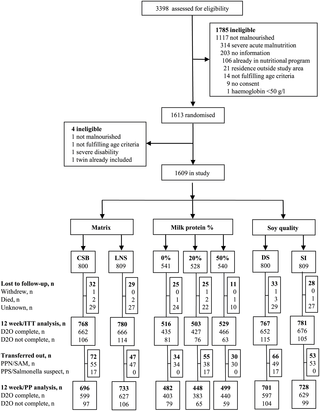PLOS Medicine ( IF 10.5 ) Pub Date : 2017-09-11 , DOI: 10.1371/journal.pmed.1002387 Christian Fabiansen 1, 2 , Charles W Yaméogo 1, 3 , Ann-Sophie Iuel-Brockdorf 1, 2 , Bernardette Cichon 1, 2 , Maren J H Rytter 1 , Anura Kurpad 4 , Jonathan C Wells 5 , Christian Ritz 1 , Per Ashorn 6 , Suzanne Filteau 7 , André Briend 1, 6 , Susan Shepherd 8 , Vibeke B Christensen 2, 9 , Kim F Michaelsen 1 , Henrik Friis 1

|
Background
Children with moderate acute malnutrition (MAM) are treated with lipid-based nutrient supplement (LNS) or corn-soy blend (CSB). We assessed the effectiveness of (a) matrix, i.e., LNS or CSB, (b) soy quality, i.e., soy isolate (SI) or dehulled soy (DS), and (c) percentage of total protein from dry skimmed milk, i.e., 0%, 20%, or 50%, in increasing fat-free tissue accretion.
Methods and findings
Between September 9, 2013, and August 29, 2014, a randomised 2 × 2 × 3 factorial trial recruited 6- to 23-month-old children with MAM in Burkina Faso. The intervention comprised 12 weeks of food supplementation providing 500 kcal/day as LNS or CSB, each containing SI or DS, and 0%, 20%, or 50% of protein from milk. Fat-free mass (FFM) was assessed by deuterium dilution technique. By dividing FFM by length squared, the primary outcome was expressed independent of length as FFM index (FFMI) accretion over 12 weeks. Other outcomes comprised recovery rate and additional anthropometric measures. Of 1,609 children, 4 died, 61 were lost to follow-up, and 119 were transferred out due to supplementation being switched to non-experimental products. No children developed allergic reaction. At inclusion, 95% were breastfed, mean (SD) weight was 6.91 kg (0.93), with 83.5% (5.5) FFM. In the whole cohort, weight increased 0.90 kg (95% CI 0.88, 0.93; p < 0.01) comprising 93.5% (95% CI 89.5, 97.3) FFM. As compared to children who received CSB, FFMI accretion was increased by 0.083 kg/m2 (95% CI 0.003, 0.163; p = 0.042) in those who received LNS. In contrast, SI did not increase FFMI compared to DS (mean difference 0.038 kg/m2; 95% CI −0.041, 0.118; p = 0.35), irrespective of matrix. Having 20% milk protein was associated with 0.097 kg/m2 (95% CI −0.002, 0.196) greater FFMI accretion than having 0% milk protein, although this difference was not significant (p = 0.055), and there was no effect of 50% milk protein (0.049 kg/m2; 95% CI −0.047, 0.146; p = 0.32). There was no effect modification by season, admission criteria, or baseline FFMI, stunting, inflammation, or breastfeeding (p > 0.05). LNS compared to CSB resulted in 128 g (95% CI 67, 190; p < 0.01) greater weight gain if both contained SI, but there was no difference between LNS and CSB if both contained DS (mean difference 22 g; 95% CI −40, 84; p = 0.49) (interaction p = 0.017). Accordingly, SI compared to DS increased weight by 89 g (95% CI 27, 150; p = 0.005) when combined with LNS, but not when combined with CSB. A limitation of this and other food supplementation trials is that it is not possible to collect reliable data on individual adherence.
Conclusions
Based on this study, children with MAM mainly gain fat-free tissue when rehabilitated. Nevertheless, LNS yields more fat-free tissue and higher recovery rates than CSB. Moreover, current LNSs with DS may be improved by shifting to SI. The role of milk relative to soy merits further research.
Trial registration
ISRCTN registry ISRCTN42569496
中文翻译:

食品补充剂在增加中度急性营养不良儿童无脂肪组织增生方面的有效性:布基纳法索的一项随机 2 × 2 × 3 析因试验
背景
患有中度急性营养不良(MAM)的儿童接受脂质营养补充剂(LNS)或玉米大豆混合物(CSB)治疗。我们评估了(a)基质的有效性,即LNS或CSB,(b)大豆质量,即大豆分离物(SI)或脱壳大豆(DS),以及(c)脱脂奶粉中总蛋白质的百分比,即、0%、20% 或 50%,增加无脂肪组织增生。
方法和结果
2013年9月9日至2014年8月29日期间,一项随机2×2×3析因试验在布基纳法索招募了6至23个月大的MAM儿童。干预措施包括为期 12 周的食品补充剂,每天提供 500 kcal 的 LNS 或 CSB,每种均含有 SI 或 DS,以及 0%、20% 或 50% 的牛奶蛋白质。通过氘稀释技术评估去脂质量(FFM)。通过将 FFM 除以长度平方,将主要结果表示为独立于长度的 FFM 指数 (FFMI) 在 12 周内的增长。其他结果包括恢复率和额外的人体测量指标。 1609名儿童中,死亡4人,失访61人,因补充品改用非实验产品而转出119人。没有儿童出现过敏反应。纳入时,95% 的人进行母乳喂养,平均 (SD) 体重为 6.91 kg (0.93),其中 83.5% (5.5) FFM。在整个队列中,体重增加了 0.90 kg (95% CI 0.88, 0.93; p < 0.01),其中 93.5% (95% CI 89.5, 97.3) 为 FFM。与接受 CSB 的儿童相比,接受 LNS 的儿童的 FFMI 增加增加了 0.083 kg/m 2 (95% CI 0.003, 0.163; p = 0.042)。相反,与 DS 相比,SI 并未增加 FFMI(平均差 0.038 kg/m 2 ;95% CI -0.041, 0.118; p = 0.35),与基质无关。与 0% 牛奶蛋白相比,20% 牛奶蛋白与 0.097 kg/m 2 (95% CI -0.002, 0.196) 的 FFMI 增加相关,尽管这种差异并不显着 ( p = 0.055),并且没有影响50% 乳蛋白(0.049 kg/m 2 ;95% CI -0.047, 0.146; p = 0.32)。 季节、入院标准或基线 FFMI、发育迟缓、炎症或母乳喂养没有影响修改 ( p > 0.05)。如果两者都含有 SI,LNS 与 CSB 相比会导致体重增加 128 g (95% CI 67, 190; p < 0.01),但如果两者都含有 DS,则 LNS 和 CSB 之间没有差异(平均差 22 g;95%) CI −40, 84; p = 0.49)(交互作用p = 0.017)。因此,与 LNS 联合使用时,SI 与 DS 相比,体重增加了 89 克(95% CI 27, 150; p = 0.005),但与 CSB 联合使用时则没有增加。该试验和其他食品补充剂试验的局限性在于无法收集有关个人依从性的可靠数据。
结论
根据这项研究,患有 MAM 的儿童在康复后主要获得的是无脂肪组织。尽管如此,LNS 比 CSB 产生更多的无脂肪组织和更高的恢复率。此外,当前采用 DS 的 LNS 可以通过转向 SI 进行改进。牛奶相对于大豆的作用值得进一步研究。
试用注册
ISRCTN 注册表ISRCTN42569496











































 京公网安备 11010802027423号
京公网安备 11010802027423号